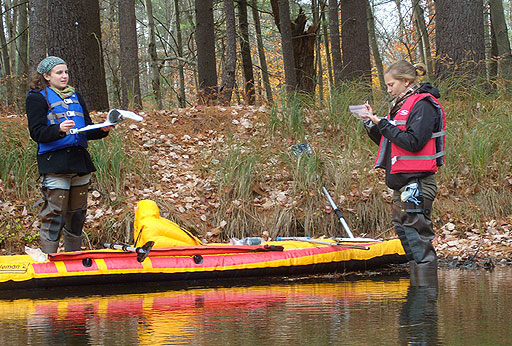Dr. Burchsted Tackles Keene's Dam Removal Dilemma

Assistant Professor of Environmental Studies Denise Burchsted may be new on campus, but she’s already got her students involved in a research project that will provide important information to the City of Keene. Not long ago, the NH Department of Environmental Services inspected the Faulkner and Colony Dam on the Ashuelot River near West St. and determined that the city must either repair the dam or take it out. Either choice will cost the taxpayers hundreds of thousands of dollars. Many environmentalists want the dam removed, to return the river to what they consider its natural, free-flowing state. Many local historic preservationists want the dam restored as an important part of our cultural heritage. Obviously, the city has a difficult and expensive decision to make; one that it cannot ignore. Doing nothing is not an option.
But, there’s hope! The city could hardly have found a professional with more expertise and experience than Dr. Burchsted to look at the dam and offer advice on the decision Keene has to make. She is a licensed professional engineer specializing in water resources, she’s the New Hampshire director for the New England Chapter of the Society for Ecological Restoration, and her research of rivers is funded by agencies such as the U.S. Environmental Protection Agency. As an engineer and aquatic scientist, she’s conducted several dam-removal and other river-restoration projects.
“There is a movement nationally and internationally to remove these old dams that no longer serve an economic purpose,” Dr. Burchsted explained. “They prevent fish from swimming up and down the river. They break the life cycle of anadromous fish — fish from the ocean that swim upriver to spawn — which kills them completely. Historically, that would include salmon, shad, eel (which travel from freshwater to salt to spawn), but also freshwater fish that travel as part of their life cycle. So a free-flowing river is critical to the health of the fish.” According to the NH Department of Environmental Services, the Ashuelot is currently included in the Connecticut River Anadromous Fish Restoration Program for smelt rearing. “A lot of dams that aren’t serving a function are being taken down to help create this important connection between upstream and downstream,” Dr. Burchsted said. “The Homestead Woolen Mills Dam downstream in W. Swanzey was removed in 2010. There are hydropower dams at the mouth of the Ashuelot, but those will have fish passages on them.”
However, Dr. Burchsted is not so ready to say that it’s a good idea to remove the dam. “‘Good’ is relative. I always tell my students that there’s no such thing as ‘good’ or ‘bad.’ The answer is ‘It depends.’ It always depends on your perspective, and this is the crux of what we’re studying. There are some people who would indeed say removing the dam is a good thing. If you’re a fish, it’s probably a good thing, but, again, that depends. If you’re someone who cares about preserving historical landmarks, it’s a really bad thing. This story is playing out all over the country and in other parts of the world.” Built sometime around 1777 to power nearby mills, the Faulkner and Colony Dam is part of our cultural heritage, and destroying it upsets people who value this heritage. And now that the dam has been here for so many years, it’s created its own ecosystem. The dam supports a lot of upstream wetlands, and those would be disturbed if the dam were removed.
“One of the things I’m pushing my class to think about—and this is a very difficult concept for people to grasp—is that prior to the dam being constructed, it’s highly probable that the river was full of natural dams, such as beaver dams and log jams,” Dr. Burchsted said. “Historically, the river probably was not free flowing. Before people constructed the dams, other things would have dammed the river, either things that fell in on their own, during spring floods for example, or that beaver placed there. And the fish evolved in this type of ecosystem. Those are the conditions that they expect. The fish require still water as well as fast water. They need the flowing water to reproduce, but their young also need a safe place to grow and they all need places to hide during floods when the river is too fast and dangerous. Ecologically speaking, the dam is a complete barrier and is problematic. Ecologically speaking, it ‘should’ be modified. But how that can best be done in order to protect some of these other habitats that are also important is a big question, and that’s what I’m pushing my students to think about. It’s a complex ecosystem that requires complex considerations.”
Dr. Burchsted studied naturally occurring dams as she worked towards her PhD, and she believes that the Ashuelot likely had plenty of natural obstructions before the first human settlers showed up. “We talk so much about what’s ‘natural,’” she noted. “The river is ‘naturally free flowing,’ and the dam is ‘not natural,’ as though humans aren’t part of nature, but if you want to set up this dualism where humans are unnatural and places without humans are natural, and you go away from where the people are, the rivers are clogged with dams—far more than we have in the cities. There are many more dams on those sections of river that are not controlled by people. Where you find the beaver dams, especially in New England and here in New Hampshire were the systems are acidic and somewhat poor, is where you find the fish. That’s where they eat, and that’s where they find shelter during floods, and that’s where the young grow and hide from predators. Natural dams are essential for thriving fisheries.
“I would bet that, before settlement, Keene was an area of open riparian forest with lots of marshes all across what is now the city, and the rivers would move a lot from year to year as beaver dams and other natural impoundments changed the course of the water flow. Then a big flood would come through and blow some of the obstructions out. That kind of environment is extremely fertile, which would attract settlers. It’s perfect for growing crops and pasturing cattle. But you can’t maintain a permanent homestead if the river keeps moving around on you, so you start controlling the river. They would fill in the marsh and control the channel, dropping the river level to drain more land. So removing the Faulkner and Colony Dam will in no way return the river to a pristine, natural state. If anything, it is continuing this progression of dropping the water table, which is unnatural.”
Dr. Burchsted’s point is that the problem is complex, and both the environmentalists and the historic preservationists have valid arguments that need to be considered. By having her students delve into the issues and offer research data on which to base a decision, they can provide critical information to the City of Keene so that it can pursue the best course regarding the dam. “I’m hoping that we can clarify the issues that the city needs to think about if they pursue dam removal, so they’ll be clearer about what impact it will have on the wetlands, for example,” Dr. Burchsted explained. “Ultimately, it’s a social decision, and we want to provide a list of the concerns. My ideal is to suggest one or two alternatives, a little more of a middle-road option that might be more ‘natural,’ so it doesn’t have to be a ‘yes-dam/no-dam’ choice between two opposites. There are things you can do to a dam besides just take the whole thing out. I’m hoping that, as a class, we can come up with other possibilities.” And something that, hopefully, will have most people in Keene feeling like they made the right choice.
For historical perspective on the dam, and to see a map showing how it looked in 1877, see the Historical Society of Cheshire County’s article on the Faulkner and Colony Mill.





